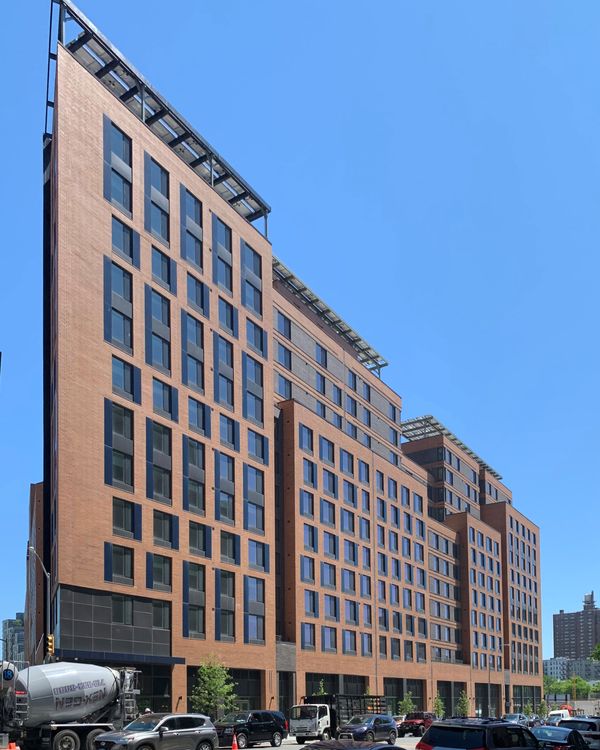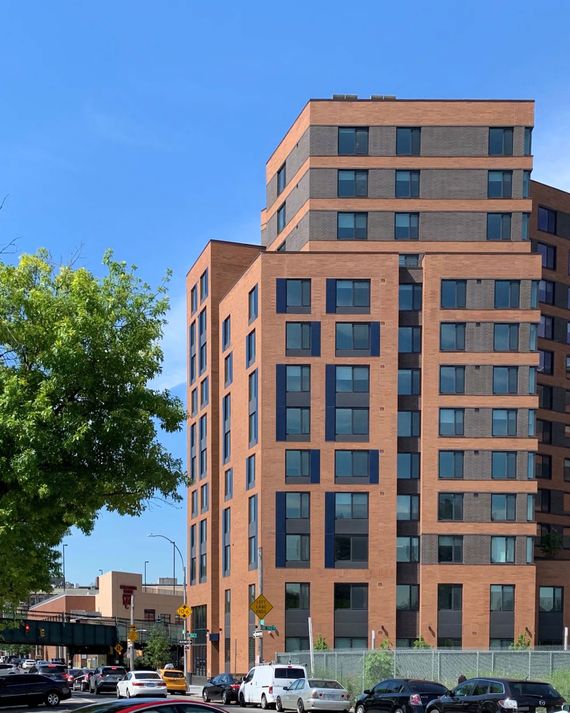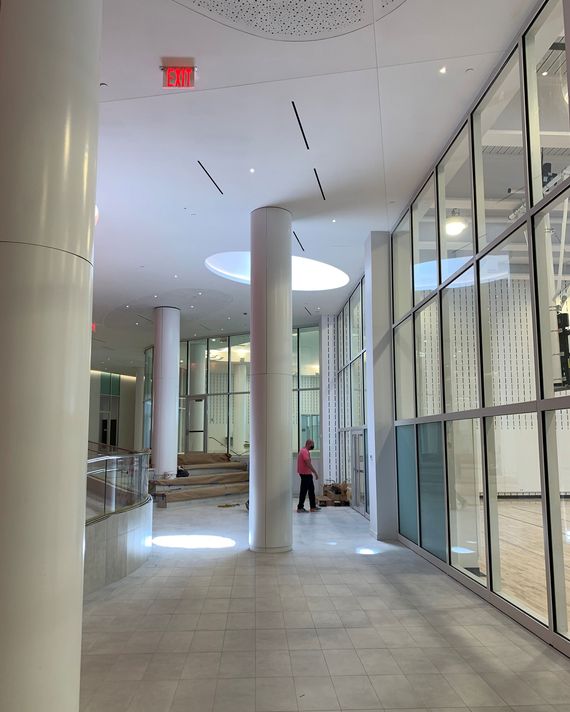Good Housing, Against the Odds

La Central.
Photo: Courtesy of FXCollaborative
On a long, pointy plot in the South Bronx neighborhood of Melrose, which is segmented by cross streets like an arrowhead that’s been shattered and glued back together, workers are putting finishing touches on the good life. The three completed buildings of the affordable-housing complex La Central have healed the scar of a long-vacant lot. Glass doors open onto the sunlit lobby of a YMCA gym and pool that would make a deluxe condominium proud. Outside, landscaped walkways, planted flower beds, and verdant roof terraces soften the city’s hard edges. The No. 2 and 5 trains clatter by on their elevated tracks, a reminder of how physically close the distant planet of Manhattan is. A few blocks away, at Third Avenue and 149th Street, the shopping area known as the Hub retains much of the storefront energy it had when the original Alexander’s department store was still in business here.
La Central is the latest campaign in the area’s 40-year war against devastation. The South Bronx is still in trouble: poor, polluted, ravaged by COVID and slow to be vaccinated. Yet its vibrancy is a testament to the persistence of local organizations like Nos Quedamos, which refused to abandon a part of New York that landlords, politicians, and the media had effectively written off. Eventually, government did learn to use its power to compensate for its decades of abusive neglect. From the Koch administration on, the city has repossessed land, rehabilitated buildings, partnered with local nonprofits, brought in developers, and bit by bit replenished a burned borough’s energy. The new complex embodies both the magnitude of that achievement and its limitations. A borough largely built under government supervision might have served as a lab for housing that’s good, quick, and cheap. Instead, what it yielded is merely adequate, glacial, and pricey. The problem is not that La Central bad, but that it’s the best we’ve got.
The complex occupies one of the last large city-owned sites, big enough for nearly 1,000 apartments in five buildings, all planned and designed by FXCollaborative and MHG Architects. The architecture of the new buildings — the final pair, including a tower with a skate park out front, will straggle along a few years from now — is a case study in working creatively within severe constraints. The cheapest, and therefore standard, approach to a 100 percent affordable building is a 12- or 13-story block-and-plank construction: Concrete blocks get piled into three parallel load-bearing walls, 30 feet apart, then bridged by concrete planks. No extra-large panes or eccentric patterns of window placement, no cantilevers, bays, balconies, or fancy shapes; just a plain rectangle bisected by a five-foot-wide corridor with apartments on either side. The distance from front door to window is roughly 25 feet. “That’s it — that’s the formula,” says Andrew Bernheimer, an architect who pivoted in mid-career from high-end to low-income residential projects, including 1490 Southern Boulevard in Crotona Park East. “We’re stuck with what we have, so you’ve got to confront those limitations and enjoy the productive friction. You can’t skate on spoons.”
At La Central, the design team, led by Dan Kaplan, made the most of that friction. Instead of sticking the laundry room in a basement, they gave it a view onto the city and placed a children’s playroom just steps away, so all those tumble-dry minutes don’t go to waste. Outside, painted metal panels flank identical windows in syncopated rhythms, making the façade look more varied than it is. These clever, inexpensive gestures signal the architects’ care and prod residents to make a corresponding emotional investment in the place they live.
Affordable-housing projects don’t leave much room for creativity. The costs are fine-tuned and the design largely preordained before the first paper is signed. But the efficiencies those techniques might have ensured are lost in a welter of paperwork. Vox’s Jerusalem Demsas recently excavated the reasons why Americans pay more for roads, trains, and tunnels than almost anyone else in the world, and concluded that the most egregious culprits were disorganization, turf battles, lawsuits, and perverse political incentives. The same is true for affordable housing: Whenever a family opens their new front door for the first time, their joy is the payoff for a system of long delays, high costs, slow success, and persistent shortages.
The site had been empty for years when the Bloomberg administration issued a request for proposals in early 2013 and gave developers four months to respond. Aaron Koffman, a managing principal at Hudson Companies, one of the co-developers of La Central, remembers that the public review process didn’t start until 2016, financing was complete in 2017, and construction began in 2018. The ribbon-cutting finally took place a few weeks ago. The lag between Hey, let’s put something here and move-in day lasted nearly a decade. During all those years of waiting around, the price of steel, concrete, and labor jumped. A building that could have been erected for $150 per square foot in 2000 now runs more than twice as much. “Time is a contributing factor, because people build in the cost of expected delays,” Koffman says. Slow motion is expensive.
This is not a one-building problem. Just about every block in the South Bronx (including Mott Haven, Hunts Point, and Melrose) was built, rehabbed, or maintained thanks to a patchwork of grants, tax incentives, vouchers, and other programs. A quarter of all apartments are in public-housing projects. According to data compiled by the Furman Institute, nearly 70 percent of the area’s rental homes involve some sort of government subsidy, a figure that doesn’t even cover rents that are regulated or paid with federally funded housing vouchers. The free market operates only around the edges.


Outside, standard-spaced windows flanked by inexpensive panels to give an illusion of variation; inside, clean basic public space. Courtesy of FXCollaborative.
Outside, standard-spaced windows flanked by inexpensive panels to give an illusion of variation; inside, clean basic public space. Courtesy of FXColla…
Outside, standard-spaced windows flanked by inexpensive panels to give an illusion of variation; inside, clean basic public space. Courtesy of FXCollaborative.
One of those edges is the waterfront facing Manhattan, where a few developers have persuaded themselves (and their lenders) that a new gold coast is in the offing. Conveniently for market-rate developers, the Major Deegan Expressway, which once divided the industrial waterfront from middle-class residential areas that fanned out along the Grand Concourse, now acts as a buffer zone between the depressed past and visions of a gold-tipped future. In 2015, the development companies Chetrit and Somerset Partners, which had bought a big juicy waterfront patch in Port Morris, staged an obnoxious “Macabre Suite” party at a former piano factory under the Third Avenue Bridge, complete with coked-up celebrities, burnt-out cars, and flickering candles. The tone-deaf extravaganza turned the Bronx’s problems into décor but failed to rebrand the neighborhood as the Piano District. A few years later, the megadeveloper Brookfield took over the site and now plans to sink nearly $1 billion into a cluster of seven towers, which, the project website boasts, will amplify the energy of a neighborhood populated with “fervent foodies, enthusiastic entrepreneurs, [and] fitness fanatics.”
One of the drivers of affordable housing all over the country is the $8 billion-a-year federal low-income-housing tax credit program, which is mostly targeted to residents earning around 60 percent of the area median income, or AMI. The state allocates those credits, which developers then sell to banks to help finance construction. All of which would be fine, except that — the law being a blunt tool — the A in AMI is the city as a whole, not the much frailer South Bronx. This leads to some strange distortions. A firefighter living alone in Melrose on a $50,000 salary would qualify for affordable housing, but a household struggling along on half that much would not. A lot of theoretically affordable housing is out of reach for the people who need it most.
Perhaps equally damaging to long-term prosperity, the system also pushes out the very people whom the neighborhood needs most: those making higher-than-average but not opulent wages — say, 130 percent of AMI. More money usually gives you more options, but that’s not always true in the South Bronx. There, a family made up, say, of a construction worker and a civil servant who grew up in Melrose would be excluded from most affordable housing and would have to hunt for lodging on an open market that barely exists. Housing advocates and progressive politicians emphasize the perpetual low-end shortages of places for the poorest poor, which are severe and crushing. With gentrification lapping at the borough’s shores, many fear that it will soon sweep inland, cheered on by rapacious developers. So far, though, north of the Deegan, the market has barely grazed a government-reinforced monoculture of poverty.
La Central is part of a long-term effort to change that dynamic, with varying rents and affordability brackets that range from 30 to 100 percent of AMI ($35,790 to $119,300 for a family of four, for example). More affluent residents help subsidize their low-income neighbors and also provide the building with some financial stability, since they are less likely to lose their jobs in a crisis — a pandemic, say. (One of the finished buildings, owned and operated by the nonprofit organization Breaking Ground, contains only supportive housing for previously homeless residents.) Slightly higher rents could encourage lenders to have more confidence in the neighborhood. That income mix makes sense when you’re close enough to see the details, but take a few steps back and it’s hard to ignore the wider view: that the city is pulling rents down with one hand and propping them up with the other.
This lunacy flows from decades of policy — or rather, a layered set of political decisions and short-term incentives that get enshrined in bureaucracy and habit. Banks, always slow to take chances on an unproven market, make construction loans based on expectations set by the government: low rents for low-income residents. Those projects flow almost exclusively to developers with an appetite for the intricate partnerships and complex financing that affordable housing requires. La Central’s $330 million construction budget had to be assembled from 17 separate sources. The closing involved so many people that they spread across two conference rooms. “At our company, we have skilled craftsmen who know how to navigate this archaic and complex system,” says Meredith Marshall, a co-founder of BRP, one of the complex’s developers. But Marshall wishes New York could do without his particular expertise. “What we need is more naturally occurring affordable housing, which we could create with smart zoning and smart tax abatements. But we’re not serious about this, so we’re not trying to fix it. Instead, we just say: Greedy developers, get out.”
These paradoxes generally get met with a chorus of regretful whaddayagonnados. Congress has historically been hostile to paying for shelter, though the Biden administration recently slathered an extra $115 billion for affordable housing on top of its previous $213 billion proposal. But aside from more money, New York needs fresh approaches, which it could collect by the basketful with a quick excursion to Vienna. Now in the home stretch of a six-year international exhibition and construction push, Austria’s capital is inviting the world to learn from experiments like Biotope City, a complex on roughly the same scale of La Central, shot through with greenery and gardens. Policymakers, lenders, architects, and developers should actually go there to see how the city, long a pioneer of low-cost housing, has modernized a robust and efficient program by subjecting it to constant tweaking. “People there love what the city does,” says Gerhard Mayer, a Viennese-born architect who heads the Los Angeles office of the West Coast firm GGLO. “There’s no NIMBY, no fear of social housing, and they are much more adventurous in terms of new building technologies, household configurations, financing mechanisms, ownership models. They try everything.” Maybe that’s a wishfully rosy view, but at least from a distance, it’s hard to contradict. I’m often told that it’s pointless to compare two cities with vastly different cultures and political histories. Yet the South Bronx is an anomaly in American life, more like Vienna than, say, Houston. It was ravaged and rebuilt, heavily populated by immigrants, with a housing market — and, to some extent, a society — shaped by government policy. And at least one aspect of the difference is quantifiable: The cost of erecting a subsidized apartment building in Vienna is half what it is in New York.
Housing — how to pay for it, who should live in it, and how much we need — is always an ideological issue, a proxy for battles over inequality and race. But a rational system, one in which low-cost basic dwellings didn’t cost more to build than luxury real estate, might go a long way toward mooting those endless arguments. Like most broken systems, it stinks because we expect and even want it to. Our dependency on a byzantine, self-defeating, slow-moving, money-sucking tangle of procedures is a kind of societal neurosis. We’re just too paralyzed to change.







